Media | Articles
How the 1955–57 “Tri-Five” Chevy became a midcentury masterpiece
As companions to Aaron’s lovely historical feature below, we are publishing three Hagerty member stories about their own Tri-Fives. You can read the first installment, about a green 1955 Nomad ex-drag car, here. The second installment, about a 1957 Bel Air convertible dream car, lives here. And lastly, our final installment about Betsy, a tattoo artist’s 1956 Chevy Bel Air Sport Sedan, here. –EW
It’s strange to start a story about some of the greatest General Motors cars ever produced with a nod to Henry Ford. But that’s where it begins, with the famous founder’s resignation in 1945 and the handing of the company keys to his 28-year-old grandson, Henry Ford II. From his perch atop his mighty arsenal of American industry, the young Deuce could see an even taller mountain just to the east, and it had a chrome bowtie on it. Ford knew what he had to do. “Here’s the car that will lead the way,” ran a subsequent Ford advertising ditty, “and beat the hell out of Chevrolet.”
Well, there were 90,000 people working for Chevrolet in the early 1950s, headed by the likes of general manager Thomas H. Keating and chief engineer Ed Cole. They weren’t going to simply roll over while Ford ate their lunch. Competition spurs innovation, and when the wraps came off the 1955 Chevrolets, the Deuce must have known that he was in a fight. Chevy showed that it was quitting the business of selling plump little economy sedans for the old folks. The ’55s were trim and direct, with a Ferrari-inspired grille, a Corvette-influenced dash, a rakish two-tone color scheme, and a new V-8 if you wanted it. The chrome and other tick-tackery were kept to a minimum—the jet taking flight on the hood notwithstanding—and the car’s bluff body lines were left to stand on their own.
Somehow, in one car, Chevy captured the boundless optimism of a nation whose youthful population was growing by 11,000 souls a day while also embodying John Wayne’s maxim to “talk low, talk slow, and don’t say too much.” The rest, as they say, is history. The 1955, 1956, and 1957 Chevys sold in the millions and became the holy Tri-Five, the beloved Shoebox Chevys (because of their boxy profile), the three cars that for a graying generation today best represent the decade of the 1950s and all their fond memories of youth, freedom, rock-and-roll, horsepower, and a prosperous suburban America at peace.
For the rest of us, the Tri-Fives, a nickname invented in later years to encompass the ’55s, ’56es, and ’57s, are simply cool, sized and styled just right and in a way that transcended the era of excess into which they were born. Today, a ’55 Plymouth is delightful; a ’55 Chevy is a national monument. Drive one through Brooklyn, Highland Park, North Kansas City, or Compton and people will flash you a thumbs up. Ford sure tried, but it couldn’t bump off the bowtie as the most American of American brands.
Marketplace
Buy and sell classics with confidence
The Tri-Five’s genesis started when Ed Cole kicked the door in at the sleepy Chevrolet Division in May 1952. Demanding and energetic, Cole had led the development of the 1949 overhead-valve V-8 at Cadillac before going off to a GM defense plant in Cleveland to run tank production for the duration of the Korean War. He arrived at Chevrolet already determined to invigorate its fusty image, with the Corvette planned for 1953 and a cut-price V-8 coming to finally answer Ford’s decadelong lead in that department. Chevy wanted younger buyers, and the youth wanted horsepower. GM had earmarked $300 million for Chevy’s 1955 model overhaul, and Cole was determined to spend all of it.
He went on a recruitment drive, luring young engineers with the tantalizing prospect of reinventing Chevrolet with bold, exuberant products aimed at performance. Then he flushed whatever the division had already been working on, shelving a V-8 project based on the expensive and heavy Cadillac motor and tasking his staff with developing an engine that was smaller, lighter, cheaper to make, but still powerful. Precision thin-wall casting and stamped rocker arms were some of the enabling technologies for a compact new 265-cubic-inch “small-block” V-8 that would launch a dynasty, the descendants of which are still in production today.
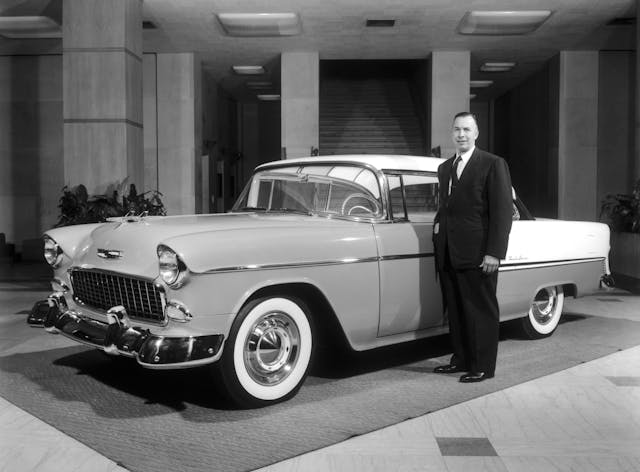
Wisely, Cole nurtured his relationship with GM’s autocratic styling chief, Harley Earl. Thus, unlike other divisional chief engineers, he was not an unwelcome visitor to the styling studio on West Milwaukee Avenue, behind the GM headquarters building in Detroit. There, through the summer of 1952 and into 1953, the ’55 Chevys emerged from sketches and clay lumps under the guidance of the division’s styling head, Clare “Mac” MacKichan.
“We were working on front ends in the studio in the early stages, and one day Harley came in and said, ‘You know, I saw a Ferrari, and I’d like to try that kind of grille on the car,’” MacKichan recalled to author Michael Lamm in 1975 for Lamm’s subsequent book, Chevrolet 1955: Creating the Original. “And then he described what he wanted and, of course, we got out magazines and pictures and started to do this grille.”
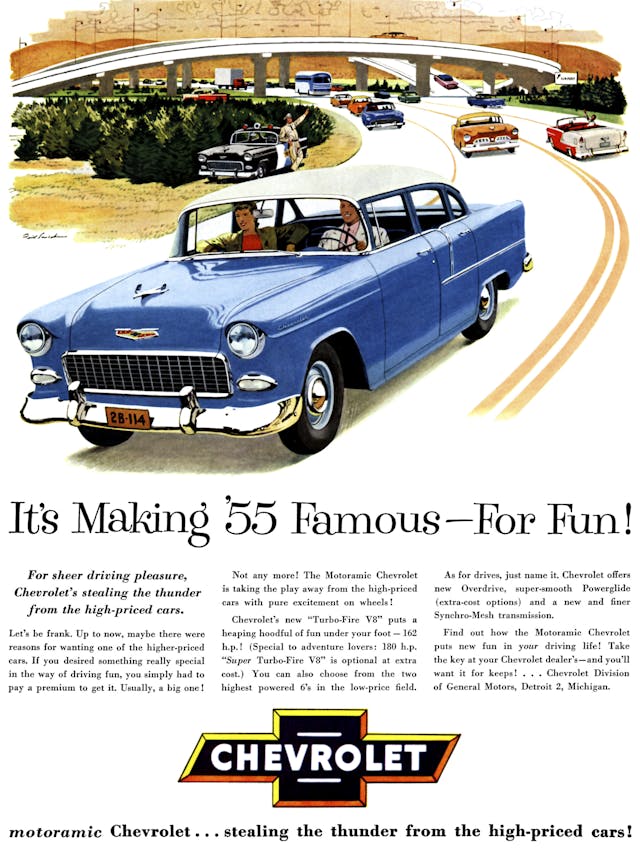
On Milwaukee Avenue, they were aiming high, trying to produce a mini-Cadillac at a Chevrolet price. Hooded headlights and frenched-in taillights that recalled a lady’s elegantly enameled fingernail were prominent Cadillac riffs. As a flourish and to accentuate the rear haunches, the designers pressed a dip into the horizontal beltline just aft of the B-pillar and accented it with a chrome band that joined to a side spear. These ornaments formed a natural border for one of the ’55’s signature elements, a white accent color on the top trim level that wrapped over the trunk and onto the opposite quarter panel.
“The Hot One,” as Chevy marketers called it, debuted officially when dealers peeled the paper off their showroom windows on Thursday, October 28, 1954. The public pressed in to see the new car—and it was indeed totally new. Of the roughly 4500 parts that went into a 1955 Chevrolet, boasted Keating, Chevy’s general manager, fewer than 700 were carryover from the previous year. Including the switch to a 12-volt electrical system, the changes, crowed the former car salesman with perhaps understandable hyperbole, “were greater than have ever been attempted by an automobile manufacturer in one year.”
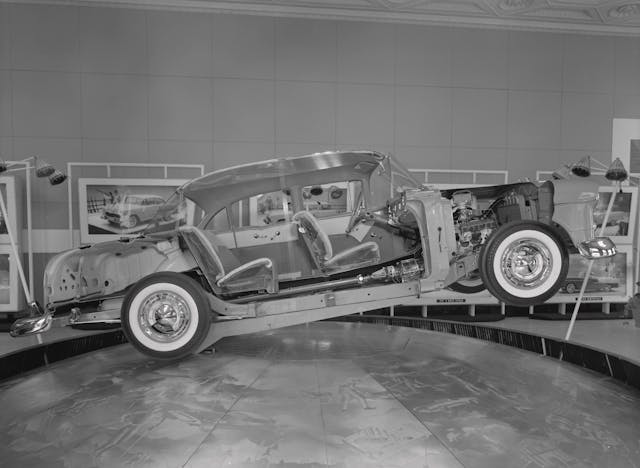
The new 162-hp Turbo-Fire V-8—or 180-hp with the optional four-barrel carb and dual-exhaust “power pack”—was said to benefit from “dynamic engine balancing” that involved spinning each engine to 700 rpm and using an “electronic brain” to measure and counterweight out any wiggle in the crankshaft. Other robotic machines were used to perfectly broach, plane, and mill the 190-pound castings of the V-8 block. For the first time, overdrive was an option on a Chevy, though priced at a steep $108.
There were three models—the base 150, the mid-priced 210, and the deluxe Bel Air—encompassing 16 separate body styles. Earl wanted to offer something special for the ’55 Chevys, so in 1953, he commanded his team to sketch a two-door wagon that used the upper half of the forthcoming 1954 Corvette Nomad show car and the bottom half of the ’55 lineup. Station wagons were red-hot sellers at the height of the baby boom, by which time 35 million Americans were said to have moved out to the suburbs. The Chevrolet Division built 160,000 wagons in 1955, the Nomad (as well as the lesser 150 and 210 versions, which weren’t called Nomads) being one of two wagon bodies offered that year. The two-door wagon claimed a healthy 54,000 sales in ’55.
However, sales were halting at first; the public took time to warm up to Chevy’s pivot. During the first two weeks, weeds grew at the dealerships, and GM president Harlow Curtice called a meeting of Keating, Cole, and other managers. Curtice arbitrarily pinned the problem on the grille, saying that Ferraris sold in the hundreds while Chevy was gunning for millions. The group sketched out a rush program to redesign the grille, but before it could be implemented, dealers began to see some traffic (the replacement grille concept was adopted on the ’56 models).

Perennial Chevrolet pitchwoman Dinah Shore rode the back of a Bel Air convertible to pace the 1955 Indy 500, while drivers Fonty Flock and Dave Hirschfield campaigned the new car in NASCAR’s various series. Kustom king George Barris wasted no time applying his touch, restyling a ’55 Chevy with Dodge trim pieces, Lincoln taillights, and a Corvette grille. Said Chevy designer Dave Holls: “If there was ever a time when the kids went 360 degrees from Fords to Chevys, it was 1955.”
By the spring of 1955, the cars were flying off lots. On April 28, a Thursday, the Chevrolet Division set a one-day industry production record, cranking out 7902 cars and 2178 trucks before the evening whistle. In announcing the record, Keating reeled off some statistics: the $20 million worth of vehicles produced by Chevy in one day would, if parked end to end, stretch 35 miles. The 33 million pounds of steel needed to make those vehicles had employed 20,000 steelworkers and was enough metal to erect a skyscraper with a base of one whole city block and a height of 25 stories. Altogether, Chevy’s plants and their suppliers had consumed 50,400 tires on that Thursday, 1.7 million pounds of paint and other chemicals, 7 million pounds of iron, 27 million gallons of water, and 650 tons of coal, while producing enough textiles to wrap around the globe four times.
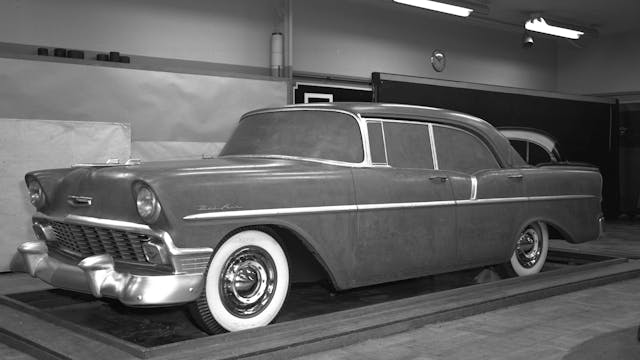
Such was the postwar industrial colossus that was Detroit, the city’s Big Three (GM, Ford, and Chrysler) owned 95 percent of the U.S. auto market in 1955. Chevrolet handily beat Ford that year, as it did in 1956 when it softened the car’s look slightly and applied the ’55’s wider replacement grille. Always a fan of chrome, Earl pressed his underlings to gussy up the now spectacularly successful Chevy line for 1957. The result was an even larger and busier oval grille bracketed by prominent bullets and bisected by a chrome center bar housing inset parking lights. The flat hood sprouted two long bulges capped by chrome rockets jutting forward, and the treatments got more deluxe as buyers moved up the line. Flashy dorsal-shaped side molding inserts for Bel Airs accentuated the new tailfins.
Though it’s revered today, the ’57s proved less popular with the public then, and Ford regained the sales crown by about 30,000 registrations. Some economists blamed the fierce battle between Chevy and Ford, with all the attendant discounts, rebates, and overproduction, for sparking the 1958 recession. It was said that pie-in-the-sky sales targets involved shoving cars on to people who couldn’t afford them (auto loan defaults climbed dramatically in 1958) while driving the few remaining independents, Nash-Hudson, Studebaker, and Packard, to the brink of bankruptcy.
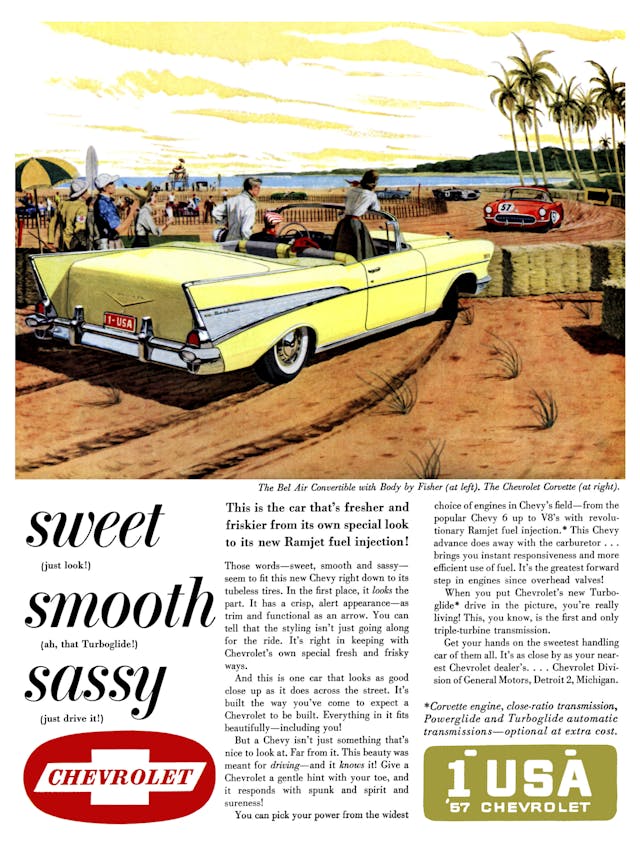
Whether true or not, Ford and Chevy continued their sales war, the latter largely abandoning vertical tailfins after ’57, flopping them over into horizontal blades before pruning them off entirely for 1961. The completely redesigned ’58 Chevys followed the industry trend toward longer and wider cars with even more chrome, and the all-too-brief Tri-Five era was over.
Except that it wasn’t. The Chevys from those three years took less time than most models to rebound from depreciating used cars into desirable classics. There’s always been something appealing about a big engine dropped into a cheap car, and the ’55 Chevy with its compact new V-8 was destined to rank with the ’32 Ford as the roots of America’s muscle car epoch.
GM turned against racing, starting with a 1957 ban by the Automobile Manufacturers Association and reinforced in 1963 by a company fearful of breakup by antitrust crusaders. That meant the Tri-Fives would represent at the drag strips in later years as the car of the grassroots independents and the little guy. Into the mid-’60s, small-block tuning pioneers such as Bill “Grumpy” Jenkins and his Monster Mash ’55 Chevy were cheered as underdogs against the newer factory jobs. Meanwhile, the Chevy Nomad seemed built to specification for the 1960s surf craze set to an epic soundtrack by The Beach Boys, Jan and Dean, and Dick Dale & His Del-Tones.
Early on the Tri-Five was a screen regular, starting with Rebel Without a Cause and the Highway Patrol TV show. Star turns in Two-Lane Blacktop (1971), American Graffiti (1973), and Diner (1982) kept the Tri-Fives in the public’s eye as the most 1950s of 1950s Americana. Go online today and you can buy Tri-Five metal signs, Tri-Five models, Tri-Five T-shirts, Tri-Five–only magazines, and couches made to look like the rear end of a Tri-Five Chevy. Those three model years support an enormous aftermarket parts industry that supplies everything to keep a Shoebox Chevy running, up to and including completely new steel body shells officially licensed by Chevrolet.

Which is why if you go to any car show, concours, cars and coffee, or cruise-in anywhere in America (and likely elsewhere), you’re all but certain to see at least one 1955–1957 Chevrolet. More than 3000 show up every year to the Tri-Five Nationals hosted by the American Tri-Five Association, whose members are certain to write in and point out with exhaustive detail any mistakes in this story.
A story which, at its heart, is about a commercial product. It was developed and built for the purposes of turning a profit over three short fiscal years in the life of a corporation that, once those years were over, quickly moved on to other matters. Car designers and engineers usually don’t know when they’re being timeless—not until some time has passed. They also don’t get to pick which of their creations qualifies; that’s for the rest of us to decide. And in the intervening years, the masses have spoken, blessing the Tri-Five with its well-earned immortality.
This article first appeared in Hagerty Drivers Club magazine. Click here to subscribe and join the club.
Check out the Hagerty Media homepage so you don’t miss a single story, or better yet, bookmark it.









My Dad bought a new ’55 Chevy, blue and ivory 4dr sedan, 6cyl, three on the tree in 1955. My Dad drove about 40 miles to a small dealer out of town with a friend to pick up the car. (He paid $2425.) I was 10 years old and was very excited to go with my Dad to pick up the car. Once the deal was done my Dad and his friend saw a hotel next to the car dealer, so they decided to stop in and raise a beer or two to celebrate the new car. I had to wait in the car as I wasn’t old enough to enter the bar. While in the car I got bored and decided to read the owner’s manual (from cover to cover) which was in the glove box. After about an hour my Dad reappeared in the new car, checking everything and looking for controls and switches, trying to figure all the functions, not sure how every worked, at which time my 10-year old mind rhymed off just about every function the car had described in the owner’s manual. My Dad, smiled at me, listened to all the instructions and away we went.
Many years later my Dad gifted me the ’55 Chevy when I was in my last year of university, and at that time it was in very bad shape. It had spent many years on heavy-salted roads in Northern Ontario and had two fully rust restorations. On the night I was to visit my bride-to-be prior to returning the Chevy to my Dad (a trip of about 500 miles) I was stopped by a local officer who was in the process of sending me the next day to get the Chevy safety-checked. (The very rusted Chevy was trialing a steady fume of blue smoke from the tailpipe, which kind of explained why I was stopped). The officer checked my ID and papers and I explained to the very friendly officer that I was leaving town the next day, to which he responded “Okay, if you promise to be out of town by 6pm tomorrow, I will let you go.”
The next day I left town, drove the 500 miles to my parents’ home and returned the Chevy to my Dad. I used 7 quarts of oil getting home, and on the last oil check at a gas stop, the attendant slammed hood down and the left head light fell out of its housing. My Dad kept the old Chevy for a while longer and finally retired it around 1970; it had 42,000. miles on the clock!) Wonderful memories of the Chevy and my Dad!
My first car was a 55 2-door hardtop Belair since that was what everyone that couldn’t afford something newer in the mid-60s had. The 55 was mostly stock 265 powerglide that I upgraded from a 2-barrel to a 4-barrel. After I graduated from high school I upgraded to a 57 210 handyman with a 350 hp 327 and a 4 speed that I had loads of fun in until I had to go into the military after that I owned several 55 and 57s but had to go to more economical cars after marriage. I paid $350 for my first 55 and boy do I wish you could still buy one for that today. I will always have a love for trifives and presently own a 57 Belair that I bought because it was a good deal but would love to pick up a 55 210 handyman to combine my favorite year with the 2-door wagon style that I had the most fun in. The 57 I have now has the original 283 with some upgrades to make it a strong runner and a 4-speed as I am an old-school guy when it comes to trifives. One thing about this article makes me wonder if Ford outsold Chevy in 57 what happened to all those 57 Fords? I see 57 Chevies almost every day but I can’t remember the last time I saw a 57 Ford.
In 1972, I bought a 55 150 2 door sedan. Primer gray, no hubcaps, 3-speed floor shift, and a 301/4 barrel. My brother and I drove it about 40 miles to a friends house and when I showed him the motor we noticed that the spark plug wires were under the passenger side valve cover. I owned that car in 1972, which would make it 17 years old at the time. In today time, that would be a 2005.
Censorship is alive and well at Hagerty. Guys, don’t mention EV’s or you’ll get censored.
It is amazing how design of the Tri-Fives have held up. Lower the body a little, put some mag wheels on and it’s a different car! I have a 56 Nomad, and when I drive it people honk, give me the thumbs up, take pictures, it’s amazing. I had it in a car show and I heard 2 women in their 40’s talking, one said, “I don’t know what it is, but I like it.
moonshiner enforce agent drove a 1957 chevrolet in thunder road
In 1974 I came across my future car at the local Buick dealer. The 57 four door turquoise & white Bel Air was up on a car display….. gleaming in its low mileage, always garaged splendor! 42k miles, radio delete, traded in by an elderly couple- original owners… for a new Buick.
I stopped my 70 VW Beetle and checked it all over – even underneath as it was elevated. A beautiful automobile.
Next day I drive the Chevrolet and the dealer wanted my VW as it was during the energy crisis. Gas rationing – lines etc.
A trade was struck.. and they offered a handsome sum for the Bug as I was out only $65.00 and the transfer fee and taxes.
The Buick boys thought the Volkswagen had lower miles… as it showed 52k – they didn’t ask me if it had rolled over. 😏 Funny how that worked out…. 🤓
We called the Chevy “ golden years” in honor of the song and the gold trimmed interior… that car really got a ton of attention. A bad car for me at the time, no garage and I used it for commuting to college 62 miles roundup daily. Not fair to this beautiful baby…..
I sold it it in 77 at a tidy profit and I know I did the right thing for the preservation of the Bel Air…. it went to a true Chevrolet family and back in a garage as it deserved. I did install a correct Chevrolet radio and I recall sweating up the brow as I drilled the fender for the antenna!
Golden Years lives on in my head and heart. All the best – and an early Happy Thanksgiving 🍁to all.
I bought TwinFins, a ’57 Townsman 210 (if I recall) wagon for $300 in 1977. Even an inept mechanic like me could work on it. Blah beige color, but looked like aqua underneath, and a military asset tag may explain the color. Had cruise control (put a brick on the pedal and it would cruise at 56 mph), laboring vacuum wipers, but it ran. Relationship with future wife survived the snowy breeze coming up through the floor. I gave it to a mechanical friend when moving, so it has a good keeper.
In 1986, I was in Istanbul, and all the taxis (it seemed) were ’56 Chevys, with a short rear deck and larger rear seating area with small drop-seats, like a Checker cab. They had disappeared a few years later.
When I became old enough to appreciate cars I was probably about 12 years old so late 1950’s or so. I absolutely loved the two door 55’s and always wanted one. Well for one reason or another life demanded different priorities so I was never able to own one. That is until about three years ago when I turned seventy years old. I found a beautiful two door hardtop 1955 Belair in excellent (restored) condition. I figured I have waited long enough, I better buy it. It now is in my garage, I drive it frequently with a smile from ear to ear. The number plate reads FNLYA55. Dreams do come true!
I received a red and white 1955 Chevrolet Bel Air 4-door sedan which my Children purchased online the year I turned fifty-five. They’d all grown up during their young lives listening to me talk about old cars, especially the 55 and 57 Chevrolet Bel Air which were my favorite.
My oldest daughter flew to Tennessee where she found the car waiting at the airport for her. Once she located the key, she placed the blanket she’d been encouraged to bring, on the “visible spring seat” and proceeded to drive it to my best friends house in Erwin, Tennessee. She had a flat tire on the way and learned to drive in the rain at a specific speed with a single windshield wiper. She had quite the adventure, arriving with a prayer on her lips. The car stopped at the bottom of my friends driveway where my daughter had to push it off the road onto the drive. Talk about having your prayers heard.
The car remained in Tennessee for about two years before we finally had it shipped to our home in Alaska.
I originally wanted to paint it “Midnight Blue and Eggshell.” The body shop owner’s son did a little research and discovered that my car is a 1955 Commemorative and asked if I’d like to go with the original color of “Gold.” He found that there had been only 5000 of them built with a single 2-door with actual gold used on some of its parts, and the remaining 4999 were 4-doors. I agreed to restore it to the original color of gold.
It’s been five years since the project began and I’ve purchased and have stored more than 90% of the necessary parts; to include white wall tires and wheels/rims, triple blast bumpers, new grille, new 10 piece glass set, seat belts, Interior, lights, new rubber/seals, I also cleaned the original trim and so much more. The initial body work is finished; engine prep complete; chassis ready with the body finally seated on it.
I dream of seeing its completed restoration. Although I’ve been saying it for nearly five years now, I am hopeful that this year will be the year. I call occasionally and am heart broken when I go to the shop and see little progress. It’s hard not to call or go by the 2-man shop. I’ve invested more than $42,000 total in parts and labor but no car. I remind myself that they’re good people with limited resources. Forever Patient for my ’55.’
The 55 has always been my favorite of the 3, but I never realized it was because of the grille.
Shoulda known, I’ve had an original Mini and 75 Dino.
Interesting article about the beloved Tri-Fives and historic significance. I *love* the styling/trim pieces that also nod to the space race. On the ‘57, the double rockets as hood ornaments, the exaggerated flared tail fins to emulate rocket fins, all the flashy chrome for a “space-age” look. I have a 57 Bel Air Townsman wagon and I love that it reflects growing large families of the time and the move to the ‘burbs. *sigh* I’m so in love with the ‘57…